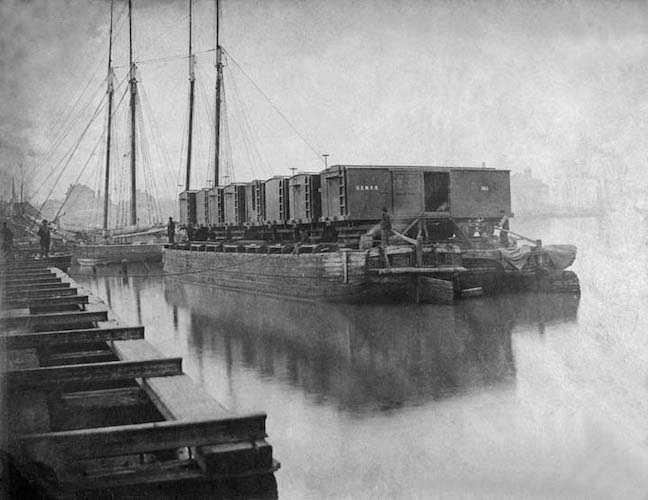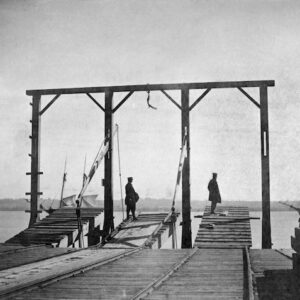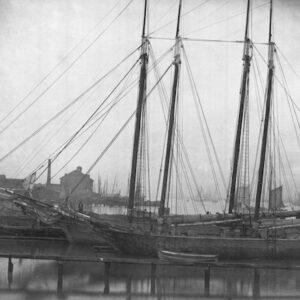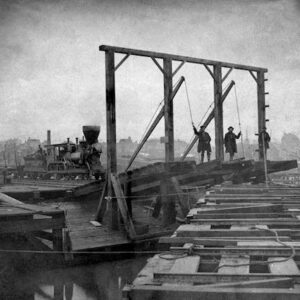| Credit: | by Russell (Andrew J.) |
|---|---|
| Date: | 1863.02-03 |
| Negative Size: | 6.5 in. x 8.5 in. |
| Equipment: | barrel |
| Locations & Lines: | Alexandria VA; Orange & Alexandria Railroad (O&A); Potomac River; Virginia |
| Military Units: | US Military Railroads (USMRR); US Army |
| Structures & Establishments: | Pioneer Mills (Alexandria VA) |
| Transports: | barge; boxcar; rowboat; schooner; USMRR boxcar 1162 |
| Sources: | Boston Athenaeum; Huntington Library; J. Paul Getty Museum; Library of Congress |
$5.99
File Details: AAAAm, 600 DPI, TIFF, Original Photograph, 17 Mb
Image ID: AAAA
Haupt, United States Military Railway Department. Construction And Transportation. No. 1. TRANSPORTATION ON THE POTOMAC. – Cars loaded at Alexandria can be carried on barges or arks to Aquia Creek, and sent to stations where the Army of the Potomac is supplied, without break of bulk. This plan has been adapted for forwarding cars, engines, and materials for the construction of roads and bridges, but has not been applied to transportation in the quartermaster’s department. It works well, and in many cases may save much of the expense incurred in the ordinary system, permitting steamers and transports to be dispensed with, and rendering large warehouses and numerous employees for transhipment of stores unnecessary.A pair of barges, as in plate 1, will carry 8 cars; but it would be preferable to lash together 4 arks, each 20 feet by 60 feet, making an area of 40 by 120 feet, capable of carrying a train of 16 cars, all of which can be loaded and unloaded without changing the position of the arks. Four tracks on the wharf, four on the arks, and four movable bridges, will be required to complete this arrangement; with it a train of cars can be loaded or unloaded in 15 minutes. A dock for loading and unloading the cars from the arks can be formed by driving a few piles on each side.
Haupt, Photographs Illustrative of Operations In Construction And Transportation, As Used To Facilitate The Movements Of The Armies Of The Rappahannock, Of Virginia, And Of The Potomac, Including Experiments Made To Determine The Most Practical and Expeditious Modes To Be Resorted To In The Construction, Destruction and Reconstruction Of Roads And Bridges. No. 1–Illustrates a mode of transportation which was adopted with great advantage on the Potomac in establishing a communication between Alexandria and Aquia Creek. It can be used to connect the various roads which have their termini on navigable rivers, and would prove of great advantage on the Western waters.
The floats used on the Potomac consisted of two large sized Schuylkill barges, across which long timbers were placed supporting eight tracks. On these tracks loaded cars were run at Alexandria, towed to Aquia Creek, landed without break of bulk, and sent to advanced stations, where their contents were distributed.
At the time of the abandonment of the Fredericksburg Railroad, in June, 1863, supplies from Falmouth and other stations in the front were loaded in cars, the cars run on floats at Aquia Creek, sent to Alexandria, landed without break of bulk, and sent forward to meet the Army which had marched overland to the line of the Orange and Alexandria Railroad. All the cars and engines were safely removed, and none of the stores lost or destroyed. Without the floats this would have been impossible.
With suitable arrangements trains can be loaded on or unloaded from the barges in a very few minutes, and by this means the multiplication of depots, the break of bulk, with the handling, waste and expense which it involves, the fleets of steamers and transports, and the risk of capture from the establishment of depots in exposed positions, would, to a great extent, be avoided. It was estimated that the general introduction of this system on the Potomac for the supply of the Army at Fredericksburg would have saved at the rate of a million and a half of dollars per annum. On the Ohio and Mississippi Rivers there may also be opportunities of using the plan with great advantage.
Haupt, Reminiscences of General Herman Haupt, plate 28. Float of Two Canal Boats Transferring Eight Loaded Cars From Alexandria To Aquia Creek.




